Don't wanna be here? Send us removal request.
Text
Why is India the First Choice for Religious Conversion Machinery?

Religious conversion has always been a sensitive topic in India, stirring debates and controversies across various social and political platforms. Despite being a diverse and culturally rich nation, India often finds itself at the forefront of religious conversion activities, particularly from Hinduism to other religions such as Christianity and Islam. This trend raises a pertinent question: Why is India such a favored destination for religious conversion machinery?
Complex Social Structure of Hinduism:
One of the primary reasons why India becomes a prime target for religious conversions is the complex social structure of Hinduism itself. The caste system, which categorizes people into different groups based on birth, has led to social discrimination and inequality for centuries. In traditional Hindu society, lower caste individuals, especially Dalits (formerly referred to as ‘untouchables’), have been marginalized and treated as outcasts. Many Dalits are not allowed entry into temples and are subjected to discriminatory practices.
When these marginalized communities face consistent humiliation and denial of basic rights, they begin to question their place in society. Conversion to another religion that promises them equality, dignity, and better treatment becomes an attractive option. For example, Christianity and Islam advocate the concept of universal brotherhood, where every believer is treated equally, regardless of their previous social standing. This inclusive approach often appeals to those who feel alienated and oppressed by the rigid caste system.
Historical Context of Conversion:
Historically, India has witnessed religious conversions for various reasons. During the British colonial rule, Christian missionaries took advantage of the social inequalities prevalent in India and offered education, healthcare, and social upliftment to the downtrodden sections of society. The promise of a better life and liberation from the clutches of the caste system attracted many to convert to Christianity.
Similarly, Islam spread in India during the medieval period through the efforts of Sufi saints, who preached equality and love for all. Many people converted to Islam, seeing it as an escape from the caste-based discrimination they faced in their previous faith. This historical context has created a perception that converting to another religion can provide social and economic benefits, making India a fertile ground for organized religious conversion activities.
If you want to know more about - Why is India the First Choice for Religious Conversion Machinery, you can visit Nishnat Verma blogs section.
0 notes
Text
The 2001 Attack on Indian Parliament: A Hidden Agenda

On December 13, 2001, India witnessed one of the most audacious attacks on its democracy—the assault on the Parliament building in New Delhi. This incident, which resulted in the tragic loss of lives and injuries to many, was carried out by five heavily armed terrorists from Pakistan-based militant groups, primarily Lashkar-e-Taiba and Jaish-e-Mohammed. The attackers aimed to disrupt the democratic process in India and send a message of terror and chaos.
The Attack Unfolds
The terrorists stormed the Parliament complex during a busy day, when numerous lawmakers were present. Armed with automatic rifles and grenades, they engaged in a fierce gun battle with the security forces. The security personnel bravely fought back, ultimately neutralizing the attackers, but not before they claimed the lives of nine individuals, including police and security personnel, and injuring many other.
In the aftermath, the attack was condemned widely, both domestically and internationally. The incident highlighted the vulnerabilities in India’s security framework, especially concerning high-profile targets. Investigations linked the attack to Pakistan-based terror networks, raising alarm over cross-border terrorism.
The Broader Context: US Involvement
While the attack itself was a stark act of terrorism, the geopolitical implications surrounding it cannot be overlooked. In the early 2000s, the United States was significantly engaged in the region, primarily focused on counter-terrorism following the September 11 attacks in 2001. India’s struggle against terrorism was closely monitored by the US, which had its agenda in the broader context of South Asian stability.
The US had a vested interest in stabilizing Pakistan, as it was a key ally in the War on Terror. However, this created a paradoxical situation for India, which was grappling with the threat posed by militant groups operating from Pakistani soil. The US often urged India to exercise restraint in its military responses to such provocations to avoid further destabilizing the region. This dynamic indicated that while the US condemned the attack, its diplomatic approach often favored Pakistan, given the latter’s strategic importance.
The Hidden Agenda
The attack on the Parliament can be seen as part of a larger chess game involving global powers. The US, while ostensibly supporting India’s right to defend itself against terrorism, also had to consider its strategic ties with Pakistan. This relationship often resulted in a lack of decisive action against terrorist groups operating from within Pakistan’s borders, which infuriated Indian leadership and public sentiment.
The aftermath of the Parliament attack prompted India to escalate its military readiness and consider retaliatory actions. However, the US exerted pressure on India to refrain from direct military confrontation with Pakistan. This led to heightened tensions but also served the US’s interest in maintaining a balance of power in South Asia, which they viewed as crucial for broader regional stability.
Additionally, this event heightened the focus on counter-terrorism cooperation between India and the US, leading to increased intelligence sharing and military cooperation. Such collaborations aligned with the US’s strategic objectives in the region but often left India feeling unsupported in its immediate needs for action against terrorism.
If you want to know more about The 2001 Attack on Indian Parliament: A Hidden Agenda, you can visit Nishant Verma blogs section.
0 notes
Text
The Rise and Fall of Dhirendra Brahmachari: From Yoga Guru to Political Power

Dhirendra Brahmachari, often remembered as one of India’s first celebrity yoga gurus, had a life that intertwined spirituality, political power, and controversy. From his humble beginnings to becoming a prominent figure in Indian politics, his journey is marked by significant achievements and equally significant misdeeds. This article delves into the complete life journey of Dhirendra Brahmachari, examining his rise to fame, his influential connections, and the controversies that led to his downfall.
Early Life and Spiritual Awakening
Born in 1924 in a small village in Punjab, Dhirendra Brahmachari was the son of a farmer. His journey into the spiritual realm began when he was a teenager, inspired by the teachings of various saints and yogis. He was determined to master yoga, a goal that led him to travel across India to learn from different masters. His dedication and hard work paid off, and he eventually became a yoga teacher, known for his unique approach that combined physical fitness with spiritual enlightenment.
Establishing a Yoga Empire
By the 1960s, Dhirendra Brahmachari had established himself as a yoga guru in Delhi. His ashram became a center for spiritual seekers, attracting a diverse group of followers. His teachings gained popularity, and he soon became a household name in India. He claimed to have developed a unique style of yoga that could cure various ailments, which appealed to many, including the elite and celebrities.
The Connection with Indira Gandhi
Brahmachari’s political connections began to flourish when he caught the attention of Indira Gandhi. Their relationship grew during the 1970s, as he became her personal yoga instructor. This connection provided him access to political circles and further enhanced his influence. Brahmachari was known to have a significant impact on Gandhi’s life, even reportedly advising her on political matters.
If you want to more about The Rise and Fall of Dhirendra Brahmachari: From Yoga Guru to Political Power, you can visit Nishant Verma blogs.
0 notes
Text
Lal Bahadur Shastri’s Mysterious Death: Was It a Conspiracy?

The sudden death of India’s second Prime Minister, Lal Bahadur Shastri, in Tashkent on January 11, 1966, remains one of the most controversial and mysterious events in Indian political history. While the official cause was reported as a heart attack, many believe it was a case of political assassination orchestrated by members of the Nehru family or others who stood to gain from his demise.
What Happened During Lal Bahadur Shastri’s Last 24 Hours?
Lal Bahadur Shastri was in Tashkent, Uzbekistan, for a peace agreement with Pakistan following the Indo-Pak war of 1965. He had successfully signed the Tashkent Agreement with the then Pakistani President, Ayub Khan, on January 10, 1966, which brought relief and hope to many Indians. However, just hours after signing this historic accord, Shastri reportedly suffered a fatal heart attack.
Why Do People Suspect Foul Play?
Several suspicious factors surround Shastri’s death, fueling speculation that it was not a natural demise:
Absence of an Autopsy: Despite the circumstances, no post-mortem was conducted. Shastri’s family repeatedly requested an autopsy to determine the cause of death, but it was denied by the Indian government. This raised suspicion that there was an intent to cover up the true cause.
Shastri’s Wife’s Statement: Shastri’s wife, Lalita Shastri, openly stated that there were visible blue marks on his body, particularly around his neck and back, suggesting the possibility of poisoning. She believed that he was murdered and demanded a thorough investigation, which was never pursued seriously.
Mysterious Missing Documents: Important documents related to Shastri’s death have gone missing or remain classified. Reports indicate that key files, including the medical reports and correspondence around his death, are not available for public scrutiny. The lack of transparency adds to the mystery.
Role of the Nehru Family?: There are theories that members of the Nehru family, particularly Indira Gandhi, who succeeded Shastri as Prime Minister, had a vested interest in his death. Shastri was a strong leader with the potential to change India’s political landscape drastically. His tenure was marked by swift decisions and reforms, and he was emerging as a powerful leader. Some believe that his growing popularity and assertiveness threatened the dominance of the Nehru-Gandhi family.
If you want to know more about Lal Bahadur Shastri’s Mysterious Death: Was It a Conspiracy, you can visit Nishnat Verma blogs sections.
0 notes
Text
Why Nehru Became India’s First Prime Minister Instead of Sardar Patel
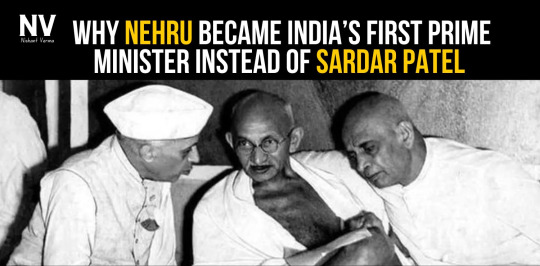
A Misguided Decision Influenced by Gandhi and the Nehru Family’s Political Ambitions
The appointment of Jawaharlal Nehru as India’s first Prime Minister instead of Sardar Vallabhbhai Patel remains one of the most debated topics in Indian political history. Many believe that the decision was not based on merit but rather a combination of Gandhi’s preference, the political aspirations of the Nehru family, and an inclination to appease certain sections of society. This article delves into why Sardar Patel, who was the natural and democratic choice, was sidelined and how this decision altered the course of India’s future.
The Congress Party’s Decision: A Mockery of Internal Democracy
The Indian National Congress (INC) had a democratic system in place for electing its leaders. In 1946, the party’s internal elections were held to choose the first Prime Minister of independent India. The overwhelming majority of the Provincial Congress Committees (PCCs) nominated Sardar Patel for the position. Out of 15 committees, 12 supported Patel, while Nehru did not receive a single vote. Despite this clear mandate, Mahatma Gandhi intervened, favoring Nehru over Patel, citing concerns about Muslim appeasement and unity.
Gandhi’s intervention wasn’t just an exercise of his moral authority; it was a decisive blow to the internal democratic process of the Congress Party. Nehru, known for his charisma and close relationship with Gandhi, leveraged these attributes to secure his position despite lacking substantial support from the party’s organizational structure.
Gandhi’s Bias and the Nehru Family’s Influence
Mahatma Gandhi’s preference for Nehru has often been attributed to his personal bias and the ideological alignment between the two. Nehru, with his Western education, socialist ideals, and modernist outlook, appealed to Gandhi’s vision of a forward-looking India. Gandhi, being the towering figure of the Indian freedom struggle, wielded significant influence over the Congress leadership, and his decision was accepted without much resistance, sidelining Patel’s candidature.
Some historians argue that Gandhi’s decision was also influenced by his perception that Nehru was better suited to handle communal issues, given his apparent secular stance and relationships with the Muslim community. Gandhi’s fear of potential communal unrest and partition-related turmoil led him to believe that Nehru would be more effective in maintaining Hindu-Muslim unity. This rationale, however, was flawed, as Patel had proven his administrative and leadership skills by integrating 562 princely states into the Indian Union, thereby maintaining national unity.
If you want to know more about Why Nehru Became India’s First Prime Minister Instead of Sardar Patel, Nishant Verma blogs.
0 notes
Text
MK Gandhi’s Truth and his hidden love for Muslim

Mahatma Gandhi’s relationship with Muslims and his efforts to foster Hindu-Muslim unity have been the subject of extensive debate. MK Gandhi’s affinity for the Muslim community and his actions in support of communal harmony were integral to his broader vision of a united India. However, some have argued that his overt support for Muslims may have come at the expense of Hindu culture and traditions. Here’s a comprehensive analysis of Gandhi’s love for Muslims and its impact on Indian society.
MK Gandhi’s Advocacy for Hindu-Muslim Unity
Mahatma Gandhi was a staunch advocate for Hindu-Muslim unity, and this sentiment shaped many of his political strategies and personal beliefs. During the Khilafat Movement in the early 1920s, Gandhi allied with Muslim leaders like the Ali brothers to support the restoration of the Ottoman Caliphate. This was a controversial move, as the issue had limited relevance to Indian Muslims but was a gesture of solidarity aimed at strengthening the Hindu-Muslim bond. Despite criticism from various quarters, Gandhi believed that supporting the Khilafat cause would bring the two communities closer together and fortify India’s independence struggle.
Gandhi’s commitment to Hindu-Muslim unity also extended to his prayers and spiritual practices. He often incorporated verses from the Quran and Islamic prayers into his ashram’s prayer sessions, even allowing Muslim prayers to be held within Hindu temples. This practice reflected his belief in the universality of religion and his desire to bridge religious divides.

Acts Highlighting Gandhi’s Love for Muslims
Allowing Muslim Prayers in Hindu Temples: Gandhi’s insistence on conducting Muslim prayers in Hindu temples stirred controversy among orthodox Hindus. His justification was that religious practices should transcend communal boundaries and foster an environment of mutual respect and tolerance. While some saw it as a positive step towards communal harmony, others viewed it as a disregard for Hindu customs and traditions.
Campaigning for Islamic Causes: Gandhi’s advocacy for Islamic causes was evident during the Khilafat Movement and his subsequent efforts to support Muslim rights in India. He spoke against the atrocities committed against Muslims during the partition and championed their rights, even when it meant alienating segments of the Hindu population. Critics argue that such actions may have indirectly undermined Hindu interests, as Gandhi sometimes seemed more focused on Muslim grievances than on the concerns of his Hindu followers.
Fasting for Communal Harmony: Gandhi frequently used fasting as a tool to protest against communal violence and foster harmony between Hindus and Muslims. His fasts were not merely symbolic; they were aimed at compelling people to introspect and embrace peace. The last fast of his life, in January 1948, was specifically to ensure that the newly independent India upheld the rights and safety of its Muslim citizens.
If you want to more about MK Gandhi’s Truth and his hidden love for Muslim, you can visit Nishant Verma blogs sections.
0 notes
Text
Why Were the English and Congress Afraid of Veer Savarkar?

Veer Savarkar’s Bold Ideology and Revolutionary Spirit
Veer Savarkar was a brave revolutionary who had a strong and fearless vision for India’s freedom. His ideas and actions were so powerful that they worried both the British rulers and the Congress party. Savarkar was known for his sharp mind, deep love for the country, and strong opposition to British rule. He didn’t just fight against the British but also spoke out against the Congress party’s policies, which he felt were too soft and aimed at appeasing different communities.
He believed in complete independence for India and was not ready to compromise on this dream. Unlike many leaders of his time, Savarkar wanted India to be truly free, without making any concessions to the British. His bold stance and revolutionary spirit made him a significant figure in India’s freedom struggle, and his thoughts continue to influence many even today. Savarkar’s legacy is one of courage, intelligence, and a fierce commitment to an undivided and strong India.

Early Revolutionary Activities
Vinayak Damodar Savarkar was more than just a patriot; he was a revolutionary who fought fiercely for India’s freedom. He was actively involved in the freedom movement and became well-known for his role in the 1909 Nashik Conspiracy Case. Because of this, the British sentenced him to double life imprisonment and sent him to the dreaded Cellular Jail in the Andaman Islands. There, he faced extremely harsh conditions and brutal treatment. The British were so afraid of his influence and ideas that they kept him isolated to stop his revolutionary thoughts from spreading among other freedom fighters.
Despite the suffering, Savarkar remained strong and determined. He used his time in jail to educate himself further, writing important works like The First War of Indian Independence. He secretly sent out messages of hope and resistance, inspiring others to continue the fight. Even in exile, he was viewed as a threat to the British, showcasing the power of his ideas and his unwavering commitment to India’s freedom. His courage and resilience became a symbol for many aspiring revolutionaries in the years that followed.
If you want to know more about on this you can visit Nishant Verma blogs.
0 notes
Text
United We Stand: The Need for Hindu Unity in Contemporary India

In the vibrant tapestry of India’s culture, the Hindu identity has stood tall for centuries. However, in today’s world, where the essence of this identity is often questioned and fragmented, it becomes imperative for Hindu unity for a common cause. The current socio-political climate of our nation presents numerous challenges that threaten our traditions, beliefs, and unity. It is time to look beyond our differences and recognize the urgent need for solidarity among Hindus to protect our heritage and ensure a prosperous future for our community.
The Divisive Climate
One of the most pressing issues we face today is the growing division among Hindus themselves. The term “Hindu” encompasses a vast array of cultures, languages, and traditions. Yet, despite this diversity, we often find ourselves at odds over trivial matters—be it politics, caste, or regional differences. This infighting is detrimental and plays right into the hands of those who seek to divide us further.
The principle of “divide and rule,” historically employed by colonial powers, remains relevant today. Various forces attempt to exploit our differences to weaken our unity. When we engage in conflicts among ourselves, we lose sight of the larger picture—our collective identity as Hindus. This disunity allows external influences to dictate our narrative, often undermining our traditions and values.
If you know want to more about on this you may visit Nishant Verma blogs.
0 notes
Text
Are Our Schools Brainwashing Hindu Students? A Call to Action for Cultural Preservation
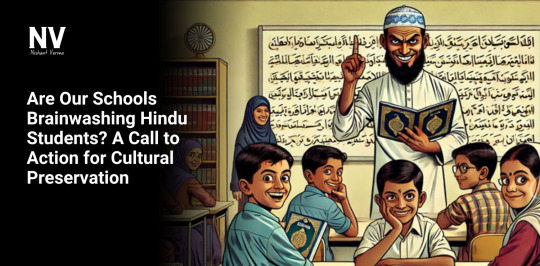
In recent years, there has been a growing concern regarding the education system in India, particularly within convent and missionary schools. Many argue that these institutions are not merely centers of learning but platforms for ideological indoctrination, particularly against Hindu values and traditions. This article delves into the issue, analyzing various perspectives on how our educational institutions may be brainwashing Hindu students and what measures can be taken to preserve our rich cultural heritage.
The Influence of Missionary Education
The videos and articles referenced highlight troubling incidents where children in missionary schools are reportedly frightened into adopting Christian beliefs, sometimes through manipulative tactics. One account even describes scenarios where children are told that praying to Jesus is necessary to avoid physical deformities. Such tactics raise serious ethical questions about the role of education in shaping a child’s worldview. Instead of fostering an environment of inquiry and respect for diverse beliefs, these institutions seem to engage in fear-based indoctrination.
Many students have reported feeling alienated from their Hindu identity while being pressured to conform to a different religious narrative. The Quora discussion reveals sentiments from both sides, with some insisting that the education system is not explicitly brainwashing but does neglect to teach Hindu philosophy and texts like the Bhagavad Gita and Ramayana. On the other hand, there are voices that assert that the omission of Hindu teachings is a systematic attempt to undermine the faith.

The Role of Political Powers
Historically, the political landscape in India has influenced educational policies. The Nehru-Gandhi family, who have held significant power in shaping India’s post-independence education system, has often been criticized for implementing laws that restrict the teaching of Hindu scriptures in schools. The argument is that this has led to a dilution of Hindu culture and values in the curriculum.
While Islamic madrasas are allowed to teach the Quran extensively, Hindu students in convent schools are often deprived of their own sacred texts. This disparity raises questions about the equitable treatment of different religious teachings within the Indian educational framework. Why is it that schools that identify with Hinduism are discouraged from teaching the scriptures, while those that align with Islam can freely promote their religious texts?
If you want to more Indian education in schools you must visit Nishant Verma Blogs sections.
0 notes
Text
Embracing Western Technology While Staying Rooted in Indian Culture

India’s journey towards modernization has been greatly influenced by Western technology, bringing about significant advancements in various fields like healthcare, education, and infrastructure. Yet, as we embrace these innovations, it’s crucial to remember our rich heritage and cultural values.
Indian culture, which emphasizes family, spirituality, and community living, has provided us with a unique identity for centuries. Western technology should be seen as a tool to enhance, not replace, our traditional way of life. While technology has made life easier, improved communication, and brought the world closer, the principles of Indian culture, such as respect for elders, love for nature, and holistic living, must not be forgotten.
How Western Technology Transformed India
The adoption of Western technology has indeed revolutionized many sectors in India. From sophisticated machinery in industries to digital platforms connecting millions, technology has opened up new opportunities. For instance, in agriculture, technological advancements have helped increase crop yields, reduce dependency on monsoon seasons, and make farming more sustainable. Similarly, in the education sector, the introduction of e-learning platforms has made quality education accessible to even the remotest parts of the country.

Why Indian Culture is Important
Indian culture is a blend of thousands of years of wisdom, spirituality, and philosophical thought. The teachings of ancient texts like the Vedas and the Bhagavad Gita offer guidance on leading a balanced life. For example, Ayurveda, a traditional system of medicine, emphasizes harmony between the body and mind, and yoga, which is now popular worldwide, originated from Indian soil. These are testaments to the depth and richness of our heritage.
Even as we navigate through the technological advancements brought by the West, we must remember that Indian culture teaches us to live sustainably, prioritize well-being, and nurture relationships. It’s important for Indians, especially the youth, to take pride in their roots and not blindly follow Western ideals.
If you want to know more about on this you can visit Nishant Verma Blogs.
0 notes
Text
Islamic Terrorism: The Greatest Threat to India’s Future
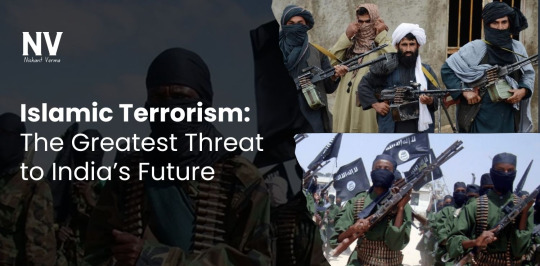
Islamic terrorism remains one of the most significant threats to India’s national security, social harmony, and economic stability. Originating largely due to Pakistan’s territorial ambitions in the Kashmir region, this menace has evolved over the decades, becoming a broader issue with financial and ideological support from various transnational organizations. If not addressed with a comprehensive and strategic approach, this threat could become even more dangerous, destabilizing India’s internal security, disrupting social cohesion, and hindering economic growth.
Historical Context: The Roots of the Threat
The origin of Islamic terrorism in India can be traced back to Pakistan’s strategic use of militant groups to achieve its objective of destabilizing India, particularly in Jammu and Kashmir. Since the late 1980s, Pakistan has supported and funded militant groups like Lashkar-e-Taiba (LeT) and Jaish-e-Mohammed (JeM) to carry out terrorist attacks in India, not just in Kashmir but across various Indian cities. The 2001 Indian Parliament attack and the 2008 Mumbai attacks serve as stark reminders of the cross-border terrorism sponsored by Pakistan. The nature of this threat, however, has evolved over the years, shifting from localized militancy to transnational jihadist movements, often drawing support from the broader global jihadist network.
The Global Network of Islamic Terrorism
The globalization of jihadist terrorism has meant that organizations such as Al-Qaeda and ISIS now inspire, recruit, and radicalize individuals across national boundaries. While these groups initially focused on regions like the Middle East and Africa, they have since extended their reach to South Asia, including India. This transnational character of terrorism is concerning because it leverages sophisticated networks for recruitment, financing, and dissemination of extremist ideologies. Even if these groups do not maintain a direct operational presence in India, they influence local terrorist outfits and lone wolves through online propaganda and clandestine funding channels.
For know more about on Islamic Terrorism, youn can visit Nishant Verma bolgs.
0 notes
Text
Godhra: True Story
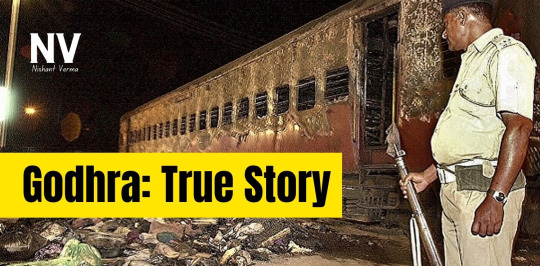
The Godhra incident and the riots that followed in 2002 are a highly sensitive and complex topic in India’s history. The incident occurred on February 27, 2002, when a train coach, the S-6 coach of the Sabarmati Express, was set on fire near the Godhra railway station in Gujarat. This tragic event resulted in the death of 59 people, most of whom were karsevaks (Hindu pilgrims) returning from Ayodhya. This incident ignited widespread communal violence across Gujarat, leading to the deaths of hundreds and leaving a long-lasting impact on the state and the country.
The Godhra Train Burning Incident
On the morning of February 27, 2002, the Sabarmati Express, carrying karsevaks from Ayodhya, made a brief stop at Godhra railway station in Gujarat. According to reports, there was a dispute between the passengers and vendors at the station, which escalated rapidly. Soon after the train left the station, a mob reportedly gathered near the train, and within minutes, the S-6 coach was engulfed in flames. The fire led to the death of 59 passengers, including women and children.

Aftermath: The Riots
The Godhra train burning incident triggered widespread riots across Gujarat, which lasted for several weeks. These riots were marked by intense violence, arson, looting, and killings, leading to the deaths of around 1,000 to 2,000 people, the majority of whom were Muslims. The violence spread rapidly to many parts of the state, and large-scale destruction of property took place.
The scale and intensity of the riots were alarming, and it soon became clear that law and order had broken down in many areas. There were reports of mobs attacking homes, businesses, and places of worship. Many people lost their lives in these targeted attacks, and thousands were displaced, seeking refuge in relief camps.
Political and Social Repercussions
The handling of the riots by the state government, led by then Chief Minister Narendra Modi, came under severe scrutiny. Many alleged that the administration and the police were complicit in the violence or failed to take adequate measures to control the situation. Accusations of bias and inaction were widespread, with some claiming that the state machinery had turned a blind eye to the violence.
This perception led to national and international condemnation, with human rights organizations, the media, and political figures raising concerns over the role of the government and law enforcement agencies. The Indian central government, led by the then-Prime Minister Atal Bihari Vajpayee, faced immense pressure to intervene, and there were calls for the dismissal of the Gujarat government.
If you want to more about on this you can visit Nishant verma blogs.
0 notes
Text
Is the Indian Economy Doomed? A Closer Look
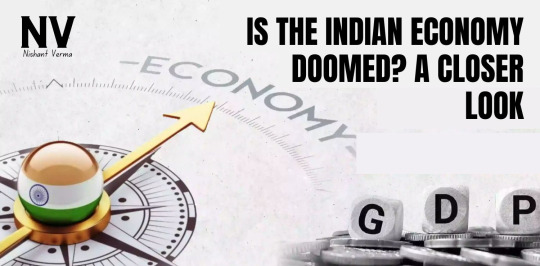
The Indian economy has long been considered one of the fastest-growing economies in the world. With a diverse population, a young workforce, and a mix of traditional and modern industries, India has had its share of ups and downs. In recent times, however, there have been growing concerns about whether the Indian economy is heading toward a crisis. Let’s explore some key aspects of the economy and see what’s going on.
Understanding Economic Growth
Economic growth refers to an increase in the production of goods and services in a country. In India, this growth has been fueled by various factors such as agriculture, manufacturing, and services. The country’s GDP (Gross Domestic Product) has consistently risen, making India one of the largest economies in the world.
However, growth alone doesn’t paint the complete picture. It’s important to look at how wealth is distributed among the population and whether the growth is sustainable in the long term.

The Current State of the Economy
Challenges in Employment: One of the most pressing issues facing the Indian economy today is unemployment. Despite the growth figures, many young people are struggling to find jobs. According to various studies, the unemployment rate has increased, especially among graduates. This disconnect between economic growth and job creation raises concerns about the long-term sustainability of the economy.
Inflation Woes: Inflation, the rate at which prices rise, is another factor causing worry. When prices increase faster than wages, purchasing power decreases, making it harder for families to afford necessities. Recently, India has experienced rising prices for essential goods, including food and fuel. This inflationary pressure can lead to decreased consumer spending, which is crucial for economic growth.
Global Economic Conditions: The global economy also plays a significant role in India’s economic health. Factors like international trade relations, global supply chains, and geopolitical tensions can impact India’s growth trajectory. For instance, recent disruptions due to the COVID-19 pandemic and conflicts in various regions have affected global trade patterns, causing uncertainty in the Indian economy.
Positive Signs Amid Challenges
Despite these challenges, it’s not all doom and gloom. Several positive indicators suggest the Indian economy is resilient.
Technological Advancements: India has seen significant advancements in technology, particularly in sectors like information technology, e-commerce, and fintech. These advancements are creating new opportunities and can potentially drive economic growth. The rise of startups and innovative solutions is helping to diversify the economy and attract investments.
Government Initiatives: The Indian government has launched various initiatives aimed at boosting the economy. Programs like “Make in India” and “Digital India” are designed to promote manufacturing and digitalization, creating jobs and attracting foreign investments. These initiatives show that there is a vision for future growth and development.
Increasing Consumer Market: With a large and growing middle class, India presents a substantial consumer market. As more people gain access to disposable income, demand for goods and services increases. This growing consumer base can drive economic growth in various sectors, including retail, hospitality, and entertainment.
If you want to more about Indian Economy Doomed you can visit Nishant Verma blogs.
#indian politics#motivation#inspiration#nishant verma#business#indianarmy#lifestyle#marketing#indian economy
0 notes
Text
The Dire Plight of Hindus in Pakistan and Bangladesh vs. The Royal Treatment of Muslims in India: A Story of Injustice and Inequality

The condition of Hindus in Pakistan and Bangladesh is a grim reminder of the vulnerability of minorities in countries where religious intolerance is pervasive. In contrast, Muslims in India enjoy privileges and opportunities that reflect the nation’s commitment to secularism and equality, despite facing certain challenges. This stark difference is the result of a historical and political narrative shaped by leaders like Gandhi and the Nehru family, whose policies weakened the position of Hindus and set the stage for the current scenario.
Hindus in Pakistan: A Community Under Siege
Hindus in Pakistan represent a minuscule percentage of the population—around 1.2%, mostly residing in the rural regions of Sindh and Baluchistan. Their situation is dire, to say the least. Historically, Hindus were a significant part of Sindh’s demographic landscape, but the violence and genocide during the partition of India in 1947 led to a massive exodus. Those who stayed behind faced systemic discrimination, marginalization, and violence. Post-Partition, the rise of religious extremism further exacerbated their plight. The constitutional amendments introduced by General Zia-ul-Haq and subsequent regimes only made things worse, pushing Hindus further to the fringes of society.
The Hindu community in Pakistan faces restrictions in accessing basic rights, including education, employment, and political representation. Their presence in government, judiciary, and armed forces is nearly non-existent. Discrimination is rampant, and they are often treated as second-class citizens. The community has suffered numerous attacks on their places of worship. In the aftermath of the Babri Masjid demolition in India, over 120 Hindu temples were destroyed across Pakistan within a week.
Apart from religious persecution, forced conversions and abductions are prevalent. Numerous cases of Hindu women being kidnapped, raped, and forcibly converted to Islam have been reported, but the authorities turn a blind eye to these injustices. The Hindu families that do survive are often landless bonded laborers, working under the mercy of powerful landlords who exploit them like slaves. Many Hindus continue to live in fear, seeking refuge across the border in India whenever possible.

Bangladesh: A Bleak Picture of Systematic Discrimination
In Bangladesh, the Hindu minority faces similar challenges. Once making up nearly 30% of the population at the time of Partition, the Hindu population in Bangladesh has dwindled to less than 8%. This decline is attributed to decades of discrimination, forced conversions, land grabbing, and systemic violence. The situation worsened with the rise of radical Islamic groups, especially after the fall of the Awami League’s Sheikh Hasina government, which was seen as a protector of minority rights.
If you want to more about on this event of Indian History you may visit nishantverma.in
0 notes
Text
The History of Subversion in India: A Simplified Overview.
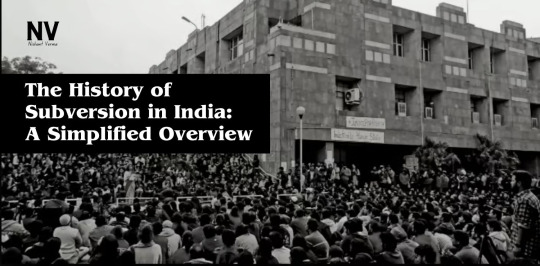
Subversion, in a political context, refers to efforts to undermine the power and authority of an established system. In India, subversion has taken many forms over the past century, from ideological influences to manipulation of historical narratives and socio-political movements. The roots of subversion in India can be traced back to the colonial era, which continued through post-independence years and was heavily influenced by both internal and external forces.
Colonial Roots of Subversion in India
The history of subversion in India began during the British colonial period. The British strategically used the divide-and-rule policy to create divisions among various communities in India. This policy not only pitted different regions and communities against each other but also laid the foundation for religious and social unrest that persisted even after independence.

During this period, there were multiple efforts to suppress native political voices and cultural identity. British historians and scholars like James Mill and Lord Macaulay often presented a distorted image of Indian history to justify colonial rule. The portrayal of Indian society as chaotic and needing the “civilizing” influence of British rule was a form of ideological subversion aimed at controlling the narrative and undermining Indigenous self-confidence.
Post-Independence Subversion: Ideological and Political Shifts
After independence in 1947, India faced new forms of subversion, especially ideological influences that sought to reshape the country’s socio-political fabric. One of the most significant influences was the spread of Marxist ideology in educational and intellectual circles. This ideological shift began during the 1960s and 70s when Marxist scholars and historians became prominent in Indian academia.
Marxist Influence on Historical Narratives.
The subversion of Indian history by Marxist historians has been a contentious issue. Scholars like Romila Thapar, Bipan Chandra, and others are often accused of presenting a skewed version of Indian history that downplayed India’s cultural heritage and glorified foreign influences. These historians are criticized for distorting facts and promoting an anti-nationalist narrative. This rewriting of history created a generational shift in understanding India’s past, where students and young minds were influenced to view Indian civilization through a colonial or Marxist lens.
For instance, the portrayal of Mughal rulers as benevolent and secular while ignoring their acts of aggression and religious persecution is often cited as an example of this subversion. Similarly, the glorification of left-wing movements and leaders while minimizing or ignoring the contributions of nationalist figures has been a major point of contention.
The Role of Communism and Left-Wing Movements
Communist subversion in India has had a long and complicated history. From the 1920s onwards, Communist parties and movements sought to influence Indian politics and labor unions. The Communist Party of India (CPI) and its offshoots aimed to create a socialist state, often in direct opposition to the policies of the Indian National Congress and other political groups.
If you want to know more about Indian History, you can visit Nishant Verma website.
0 notes
Text
Appointment of Nehru’s as First Prime Minister
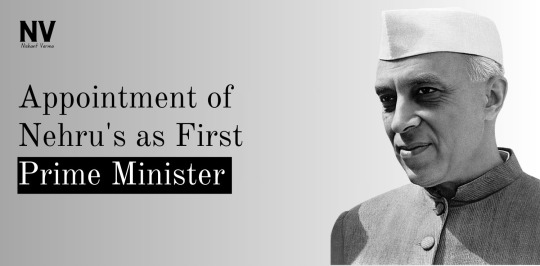
After India gained independence in 1947, the Congress Working Committee had to decide who would become the first Prime Minister. During this process, Sardar Vallabhbhai Patel received the majority of nominations from the Pradesh Congress Committees (PCCs). However, Mahatma Gandhi, the most influential leader at the time, intervened and endorsed Jawaharlal Nehru instead, a move that significantly altered the decision.
Why Jawaharlal Nehru’s as First Prime Minister Was Chosen Over Patel?
Gandhi’s Influence and Personal Preference: Despite Patel’s overwhelming support, Gandhi’s endorsement of Nehru was crucial. Mahatma Gandhi believed that Jawaharlal Nehru had a more modern and progressive vision for India, which included his secular stance and internationalist outlook. Gandhi felt that Nehru, with his popularity among the masses and connection with youth, was better suited to represent the newly independent nation on the global stage.
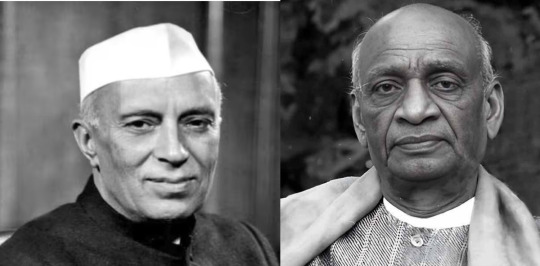
Nehru’s Position on Minorities: One of the arguments often cited for Gandhi’s preference was Nehru’s commitment to safeguarding the interests of minorities, especially Muslims. In contrast, there was a perception that Patel, known for his decisive role in the integration of princely states, might adopt a harder stance on communal issues. Gandhi was concerned that Patel’s approach could alienate Muslims and further communal tensions post-Partition.
Nehru’s Alignment with Gandhi’s Ideals: Nehru was seen as more aligned with Gandhi’s vision for India. Gandhi viewed Nehru as someone who would keep India committed to the ideals of secularism, socialism, and democracy. Gandhi was also aware that Nehru had been a staunch supporter of his movements and philosophy for decades.
Analysis: Nehru and Gandhi’s Real Intentions
Critics often argue that the decision to choose Nehru was not transparent and ignored democratic principles within the party. Many believe that Gandhi’s endorsement had more to do with personal biases and less to do with democratic decision-making.
The Question of Sardar Patel’s Exclusion: Sardar Patel was a strong contender and had immense support from Congress leaders and the public. His exclusion is viewed by some as a deliberate move to ensure that someone more pliable to Gandhi’s influence took the helm.
If you want to more about this you can visit: nishantverma.in
0 notes
Text
The Impact of Lord Macaulay on India’s Education System and Culture
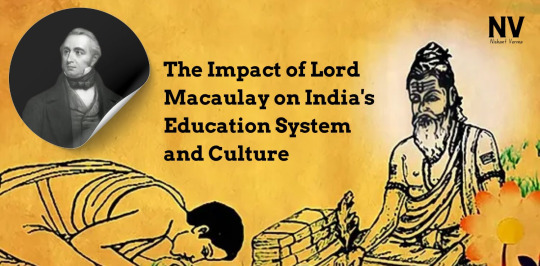
Lord Thomas Babington Macaulay, a British historian and politician, played a pivotal role in shaping the modern Indian education system. His legacy is often seen as a deliberate attempt to undermine India’s rich cultural and educational heritage, especially the traditional Gurukul system that existed before British colonization. Lord Macaulay policies, which emphasized Western education and values, led to significant changes in the way Indian history, culture, and traditions were documented and taught. This article delves into the impact of Lord Macaulay’s educational reforms and how they altered India’s historical narrative.
The Traditional Indian Gurukul System

Before the British established their rule, India had a robust educational system. The Gurukuls were centers of learning where students stayed with their gurus (teachers) and holistically received education. Subjects ranged from philosophy, mathematics, science, and astronomy to arts, spirituality, and practical life skills. The system fostered a deep connection with Indian values and traditions, instilling moral and ethical principles alongside academic knowledge.
This indigenous system produced scholars, philosophers, and scientists who made significant contributions in various fields. The focus was not just on rote learning but on developing a comprehensive understanding of life and knowledge. However, the British colonizers, under Lord Macaulay’s guidance, perceived this system as a threat to their rule and sought to replace it with one that would produce a class of Indians who would serve the colonial administration.
Lord Macaulay’s Educational Policy: A Systemic Overhaul
In 1835, Macaulay introduced his famous “Macaulay Minute” on education, which laid the groundwork for a new education policy in India. He openly criticized the traditional Indian education system, claiming that it was of little use for modern governance. Macaulay argued that the existing Sanskrit and Persian literature was inadequate and backward, advocating for English to be the medium of instruction. His words captured his intentions: “We must at present do our best to form a class who may be interpreters between us and the millions whom we govern, a class of persons, Indian in blood and color, but English in taste, in opinions, in morals, and intellect.
If you want to know more about on this you can visit nishantverma.in
0 notes